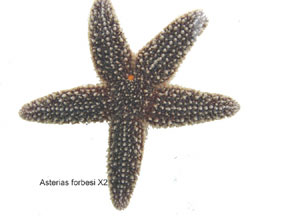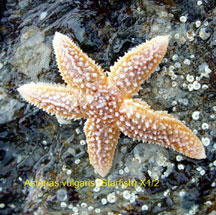 |
 |
|||||||||||||||
|
The last group of animals we'll discuss are sea stars. Sea stars belong to the phylum Echinodermata. The name "echinoderm" can be translated into "echino" meaning spiny, and "derm" meaning skin, put it together and the result is "spiny-skinned." Other rocky shore invertebrates that belong to this phylum include sea urchins, which we've discussed in the subtidal zone. Echinoderms, including sea stars have pentaradial or 5-part body symmetry. Their spiny skin is the result of calcareous plates that give the animal rigidity. Tube feet protrude from these plates. These tube feet are equipped with small suction cups and used for locomotion. The tube feet are operated by a complex hydraulic water vascular system. The focal point of this vascular system is the madreporite or sieve plate. This is the small orange or yellow dot on the upper side of the sea star, it is sometimes mistaken for an eye. The madreporite can open and close like a faucet allowing water into the sea star's body to aid in operating the hundreds of tube feet. Three commonly found sea stars are pictured above. The common sea star, Asterias forbesi, on the left is usually a dark green in color with a distinct orange madreporite. The Northern sea star, Asterias rubens, is pictured in the middle. The Northern sea star can be yellow to orange to pink in color, with a pale yellow madreporite. On the right is the blood star, Henricia spp. The blood star is smoother to the touch, small in size and lacks a madreporite. Look for sea stars in the lower intertidal, they often hide under seaweed canopies and in rock crevices. |
||||||||||||||||
Did you know... |
||||||||||||||||
|
||||||||||||||||



